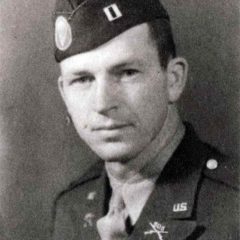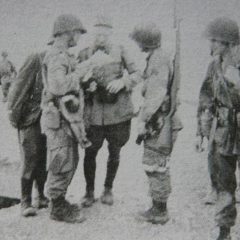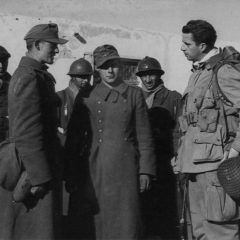OPERATION TORCH
In the afternoon of November 7, 1942, 556 paratroopers of the new 2/509th Parachute Infantry Regiment (the unit being called 2/503rd PIR before November 2, 1942) waiting on the tarmac of Predannack and St. Eval airfield. Thirty-nine C-47 of the 60th Troop Carrier Group are reunited for the operation.
The French North Africa is still controlled by the Vichy government and the time of the operation, it is unclear if the French would fight or surrender. For this, two airborne plans are divided: the Peace and War Plan. If the French decide to resist the allies, the War Plan will be located on aerodromes of La Senia and Tafraoui respectively 15 miles and 5 miles south of Oran, and will be caught in during a night jump. But if the French cooperate on landing, the Peace Plan will be conducted and the 509th will land an airplane on the airfield of La Senia with the help of the French.
On the evening of November 7, 20 planes take off from St. Eval and 19 from Predannack a few kilometers away and began his 1500-miles-journey flight to seize airfields located near Oran, Algeria, where he will perform the first airborne assault the US Airborne, realizing the longest combat flight in history.
Just before departure, we inform the paratroopers that the Peace Plan is selected and a quiet landing on the airfield of La Senia be made but this will not happen as planned. The battalion is convinced that the French Vichy will not fire on the Americans. Except that the cons-order (War Plan) never reached the C-47 in flight.
Over Spain, a strong wind scattering the planes and do not receive any signals of a British ship that was guided to North Africa. At dawn of November 8, the 39 C-47 are scattered from Spanish Morocco to points east of Oran, and instead of a peaceful reception, the French are restisting the landings. As some of the lead planes began their descent on La Senia airfield, they came under intense antiaircraft fire. The pilots are able to avoid the airfield and land the planes on a dry lake bed west of Oran.
Meanwhile, six aircraft, including the commander, Lt. Col. Edson D. Raff, head towards the drop zone on the airfield of Tafraoui. Approaching the airport, Raff noticed a column of tanks and orders his men to jump and attack the column. Just before landing, the troopers soon realize that the vehicles coming from the beaches and they are American.
Raff's men arrive to join the others who had landed on the salt lake of Sebkra and it was decided to charge men as much as possible in three aircraft who had enough fuel to reach the airfield of Tafraoui. Captain John Berry' E Company and some members of the HQ Company cram into the 3 planes. Soon after the take off, the planes are attacked by French Dewoitine fighter planes and forced to make an emergency landing: four men were killed by the fighters and fifteen were wounded.
Got Injured ribs when jumping, Raff directs what is left of his battalion (8 aircraft are missing), to join forced march to Tafraoui.
March to Tafraoui
During his walk, Raff is able to get a jeep from the armored column he had taken for enemy. Moreover, Lt. Col. John Waters' tanks (701st Tank Destroyer Battalion) took over Tafraoui and took 300 prisoners. All of he 8 november and part of the 9, Raff progressing painfully towards the airfield. His Executif Officer, Doyle Yardley commandeers a bus. The men of the 2/509th escorted by Arab groups seeking to exchange (or steal) any US object.
Meanwhile, Yarborough was able to gather 61 men roughly valid well Overworked St. John survivors French strafing. He began to turn the long walk to reach Raff, through this muddy salt lake called Sebkra Oran.
Eventually, the paratroopers reached both airfields and were greeted by American ground troops who had secured them earlier in the day.
Missing planes
Nine other aircraft are still missing and are... in Casablanca. A plane lands with dry fuel in Gibraltar, and four in Spanish Morocco. The Spanish hold crews and troopers for 3 months until they release, but they keeping the C-47. However, one of the four planes had managed to take off again and reach the Sebkra in the day. Two planes land in Fez, Morocco, and were briefly held prisoner by the French.
Two others who have traveled together to try to land at La Senia early in the morning. They are driven by the DCA and because of dry reservoirs are forced to land on the plain on the other side of Oran. Crews and troopers aboard the two aircraft are captured by the French. The last two planes landed at Fez in Morocco and French were captured by the legionaries.
A total of four paratroopers and two C-47 pilots were killed. The paratroopers are: Lt. Dave C. Kunkle, Cpl. E. Wilbert Sprenkle and Pvt. Ira L. Brookins John T. Mackall
Youks-les-Bains
Following the success of Operation Torch including the capture of Algiers, Oran and Casablanca, the allies decided to continue their progress in Tunisia.
Lt. Col. Edson Raff is entrusted with the mission to seize Tebessa airfield on the 15 of november near the Tunisian border, 640 kilometers from the most advanced Allied troops. No information is available about the defenses of the airfield or even its location. By pure chance, Raff learns through two French pilots that another airfield, three times larger, is located nearby, in the town of Youks-les-Bains. The drop zone is larger and it was agreed to take priority then grab one of Tebessa.
A rigger section is set up to repair the paratroopers equipment. On November 12, 150 paratroopers led by Lt. Col. Raff are sent to Tafraoui Airfield in Maison Blanche near Alger. Two days later, 170 men led by Doyle Yardley are sent there. Finally a little less than 350 paratroopers arrive to be equipped.
At leat, 304 paratroopers boarded 22 C-47 in Maison Blanche on November 15 at 6:30. Six fighter planes fly with them to avoid the enemy attack. Despite his injuries received during the jump 7 days early, Raff is ahead of his men. Youks-les-Bains airfield is located without much difficulty. One of two French pilots had roughly sketched its location on the only map available for Raff. The presence of troops on the airfield is noticed. Raff gives the order to jump at 900 meters at 9h30. The airfield is being beautifully defended a whole network of trenches, machine gun batteries, all supported by 75mm guns. But the French refrain to opening fire and rush to help the troopers to disengage from their harnesses, and to help the wounded who landed on rocky foothills. Fifteen men in total got broken limbs. E/509 commander’ Capt. John T. Berry suffer a fracture. On the ground, the troopers realize that if the French were not in their camp, they would probably all dead.
French and Americans quickly become friends. French soldiers responsible for guard Youks airfield are part of the 3rd Zouave commanded by Colonel Albert Berges. Raff receives a token of friendship red fodder that the 3rd Zouaves had won during the World War One and their insignia. In exchange Raff seam its invasion flag and tenders to Colonel Berges. Raff continue to wear the forage throughout the Tunisian campaign.
Captain Morrow organized the defenses of the airfield with the help of the French while Captain Alden tending the wounded with the help of French medics. E Company led by Yardley grows up Tebessa to occupy the airfield that is captured without opposition.








